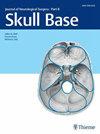The Role of the Transeptal Window in Endoscopic Endonasal Access to the Contralateral Orbit
IF 0.9
4区 医学
Q3 Medicine
引用次数: 0
Abstract
Abstract Objective This study aimed to objectively compare maneuverability at the contralateral medial orbit when approached through the traditional endoscopic endonasal approach (EEA) and EEA with transeptal window (TW). Study Design Anatomic dissections were performed bilaterally on three latex-injected cadaveric heads. Approaches were performed sequentially; initially, an EEA was fashioned. Binostril access was achieved through a 2-cm posterior septectomy. The second stage pertained to the TW dissection. Area of exposure (AoE), surgical freedom (SF), and angles of attack (AoA) were measured along the contralateral medial orbital wall and compared for each approach. Additionally, the study presents an illustrative case describing the application of the EEA + TW for resection of an intraorbital schwannoma. Results Compared with EEA, EEA + TW yielded a significantly greater AoE along the contralateral medial orbital wall (39.45 vs. 48.45 cm2, respectively; p = 0.002). SF was statistically different between the EEA and EEA + TW (1153.25 vs. 2256.33 cm2, respectively; p = 0.002). AoA in the horizontal plane were significantly broader with the EEA + TW (6.36 vs. 4.9 degrees by EEA; p = 0.015). A 50-year-old male with a right medial extraconal orbital tumor was successfully treated through an EEA using the transeptal corridor to access the medial orbital region. No long-term complications were encountered after 31 months of follow-up. Conclusions EEA + TW is a minimally invasive technique that maximizes exposure and maneuverability within the medial orbital wall, allowing resection of lesions that extend anteriorly. EEA + TW limits disruption of the nasal septum and overcomes the obstacle that intranasal anatomy represents for instrumentation.经鼻中隔窗在鼻内窥镜进入对侧眼眶中的作用
摘要目的客观比较传统内镜鼻内入路(EEA)与经鼻中隔窗(TW)入路对侧内眶的可操作性。研究设计对三具注射乳胶的尸体头部进行双侧解剖。方法按顺序进行;最初,欧洲经济区形成了。通过2厘米的后隔切除术获得双鼻孔通路。第二阶段为TW解剖。沿对侧眶内壁测量暴露面积(Area of exposure, AoE)、手术自由度(surgical freedom, SF)和攻角(angle of attack, AoA),并对各入路进行比较。此外,该研究还提出了一个示范性案例,描述了EEA + TW在眼眶内神经鞘瘤切除术中的应用。结果与EEA相比,EEA + TW沿对侧眶内壁的AoE显著增大(分别为39.45 cm2和48.45 cm2);P = 0.002)。EEA与EEA + TW的SF差异有统计学意义(分别为1153.25和2256.33 cm2);P = 0.002)。EEA + TW在水平面上的AoA明显更宽(6.36度vs. 4.9度);P = 0.015)。一例50岁男性右内侧眶外肿瘤患者通过经隔通道进入眶内区,经EEA手术成功治疗。随访31个月,无长期并发症发生。结论EEA + TW是一种微创技术,最大限度地暴露和可操作性在眶内壁内,允许切除病变向前延伸。EEA + TW限制了对鼻中隔的破坏,克服了鼻内解剖为内固定所带来的障碍。
本文章由计算机程序翻译,如有差异,请以英文原文为准。
求助全文
约1分钟内获得全文
求助全文
来源期刊

Journal of Neurological Surgery Part B: Skull Base
CLINICAL NEUROLOGY-SURGERY
CiteScore
2.20
自引率
0.00%
发文量
516
期刊介绍:
The Journal of Neurological Surgery Part B: Skull Base (JNLS B) is a major publication from the world''s leading publisher in neurosurgery. JNLS B currently serves as the official organ of several national and international neurosurgery and skull base societies.
JNLS B is a peer-reviewed journal publishing original research, review articles, and technical notes covering all aspects of neurological surgery. The focus of JNLS B includes microsurgery as well as the latest minimally invasive techniques, such as stereotactic-guided surgery, endoscopy, and endovascular procedures. JNLS B is devoted to the techniques and procedures of skull base surgery.
 求助内容:
求助内容: 应助结果提醒方式:
应助结果提醒方式:


